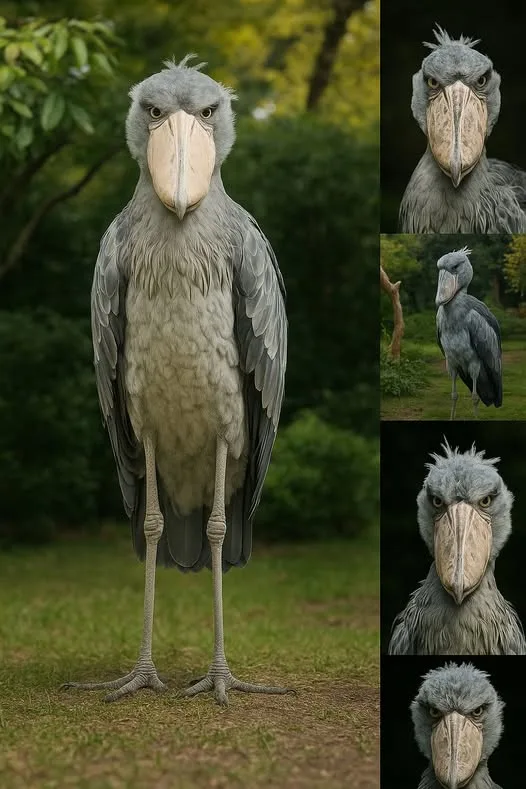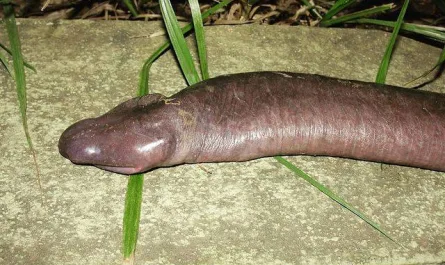Introduction
In the heart of East Africa’s sprawling wetlands, a creature stands as a living relic of prehistoric times—the Shoebill Stork. With its towering height of up to 5 feet, an impressive 8-foot wingspan, and an unblinking gaze that seems to pierce through the soul, this bird is one of nature’s most formidable hunters. Often described as fearsome and silent, the Shoebill doesn’t rely on speed or showy displays. Instead, it rules its domain through an uncanny stillness and precision. On this Wednesday morning, July 9, 2025, at 11:59 AM +07, let’s dive into the world of this enigmatic bird, exploring its unique traits, hunting prowess, and the quiet dominance it exerts over its watery kingdom.

A Prehistoric Presence
The Shoebill Stork (Balaeniceps rex) looks like it stepped out of a dinosaur-era fossil record. Its massive, shoe-shaped bill—measuring up to 9 inches long—gives it an unmistakable silhouette, while its slate-gray plumage and piercing blue eyes add to its otherworldly appearance. Standing motionless in the swamps of Uganda, South Sudan, and Zambia, it blends seamlessly with the reeds, its stillness a stark contrast to the bustling life around it. This bird’s evolutionary lineage traces back millions of years, earning it the nickname “the dinosaur bird” among locals and wildlife enthusiasts. Its prehistoric vibe isn’t just aesthetic—it’s a hint at its ancient survival strategies that have thrived unchanged for eons.
The Art of Silent Hunting
Unlike many predators that chase or call to intimidate, the Shoebill employs a strategy of patience and precision. It doesn’t blink, smile, or miss its mark. Perched on the edge of a swamp or wading through shallow waters, it waits for hours, its body a statue against the horizon. When prey—such as lungfish, eels, or even baby crocodiles—ventures too close, the Shoebill strikes with lightning speed. Its bill snaps shut with a sound so sharp it’s been dubbed the “death clap” by those who’ve witnessed it, a crack that echoes across the wetlands like a gunshot. This powerful tool can exert immense pressure, capable of crushing the skulls of its prey or spearing fish with surgical accuracy. This methodical approach ensures that the Shoebill rarely wastes energy, embodying a hunter that thrives on focus rather than frenzy.
A Diet Fit for a King
The Shoebill’s menu reflects its status as an apex predator in its ecosystem. Its primary targets include lungfish, which it plucks from muddy bottoms, and eels, which it wrestles with its strong bill. But its appetite doesn’t stop there—reports of Shoebills preying on baby crocodiles and water snakes showcase its boldness. This diverse diet requires not just strength but adaptability, as the bird adjusts its hunting tactics to the behavior of its quarry. Juveniles often learn from adults, observing the art of the wait-and-strike method, ensuring the survival of this rare species. With a population estimated at fewer than 10,000 individuals, every successful hunt is crucial to its continued existence.
Ruling Through Stillness
In a world filled with the chatter of birds and the rustle of wildlife, the Shoebill stands apart. There’s no flapping of wings or warning calls—just an unwavering watchfulness. This stillness is its superpower, allowing it to conserve energy in the hot, humid wetlands while remaining ever-ready to pounce. Local communities revere and fear it, with tales of its eerie presence woven into folklore. It’s not angry or aggressive; it’s simply always observing, a sentinel of the swamp. This quiet dominance has earned it a reputation as a master of its domain, a bird that commands respect without uttering a sound.
Conservation and the Future
Despite its prowess, the Shoebill faces threats from habitat loss due to drainage of wetlands for agriculture and human settlement. Conservation efforts are underway to protect its fragile ecosystem, with organizations monitoring nesting sites and raising awareness. As technology like drones and camera traps continues to aid research, we’re learning more about its behaviors and needs. On this July day in 2025, the Shoebill remains a symbol of nature’s resilience, a reminder of the delicate balance between survival and extinction.
Conclusion
The Shoebill Stork is more than a bird—it’s a testament to the power of patience and the beauty of the wild. Its unblinking stare, prehistoric grace, and silent strikes paint a picture of a predator that thrives on its own terms. As we marvel at its “death clap” and towering presence, we’re invited to pause and appreciate the stillness that defines its life. In a noisy world, the Shoebill teaches us that sometimes, the greatest strength lies in waiting, watching, and striking when the moment is right.





